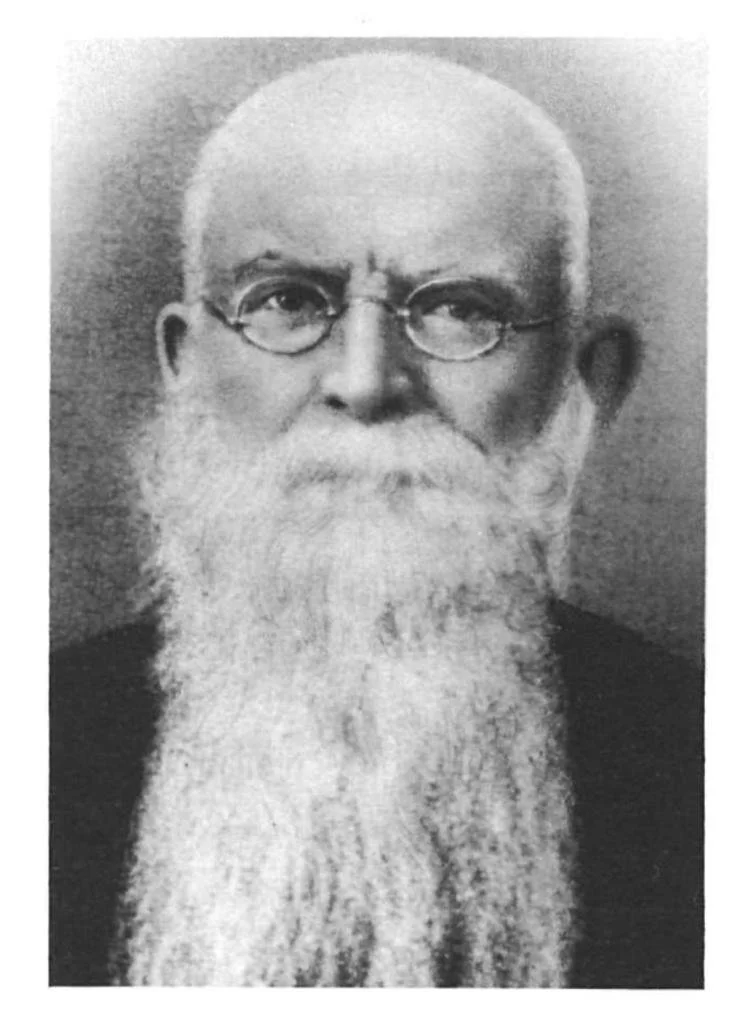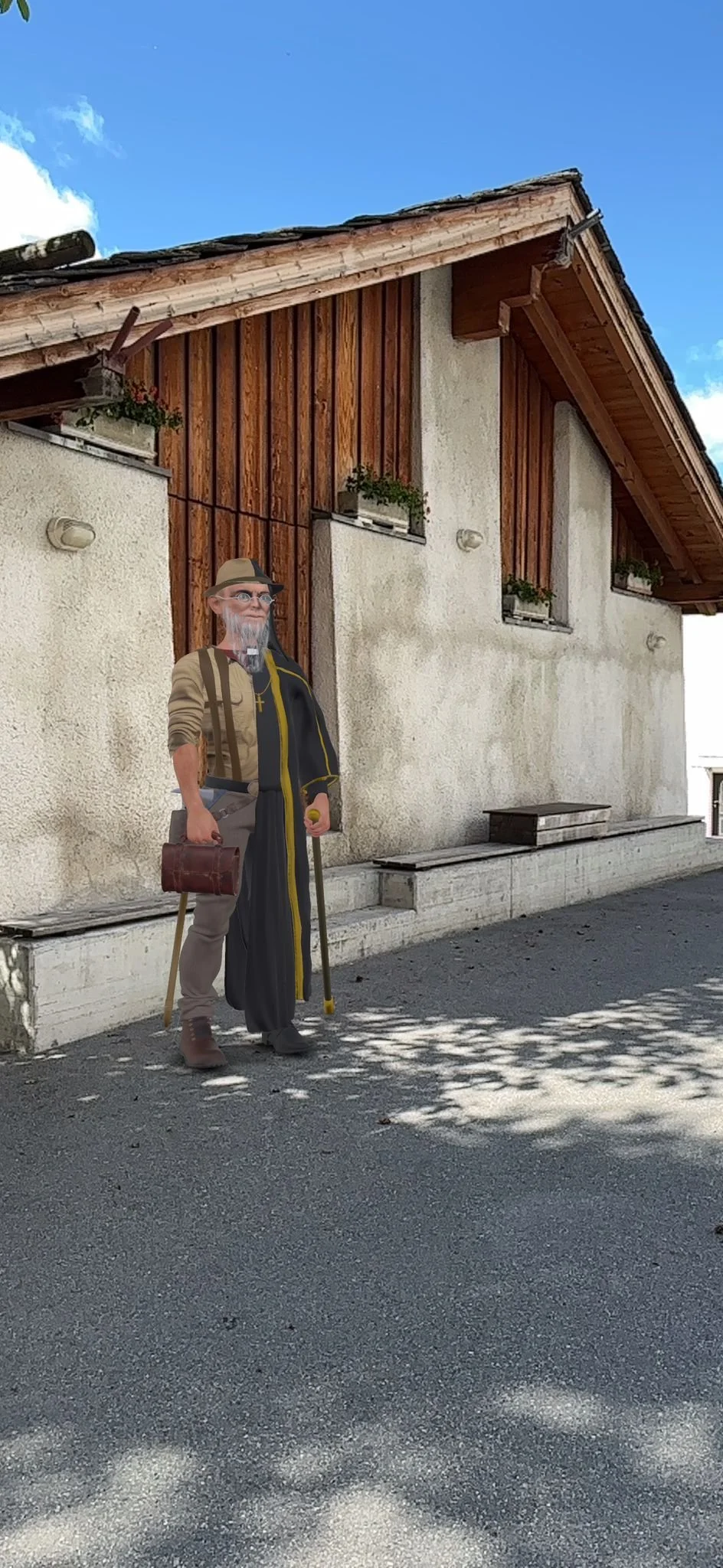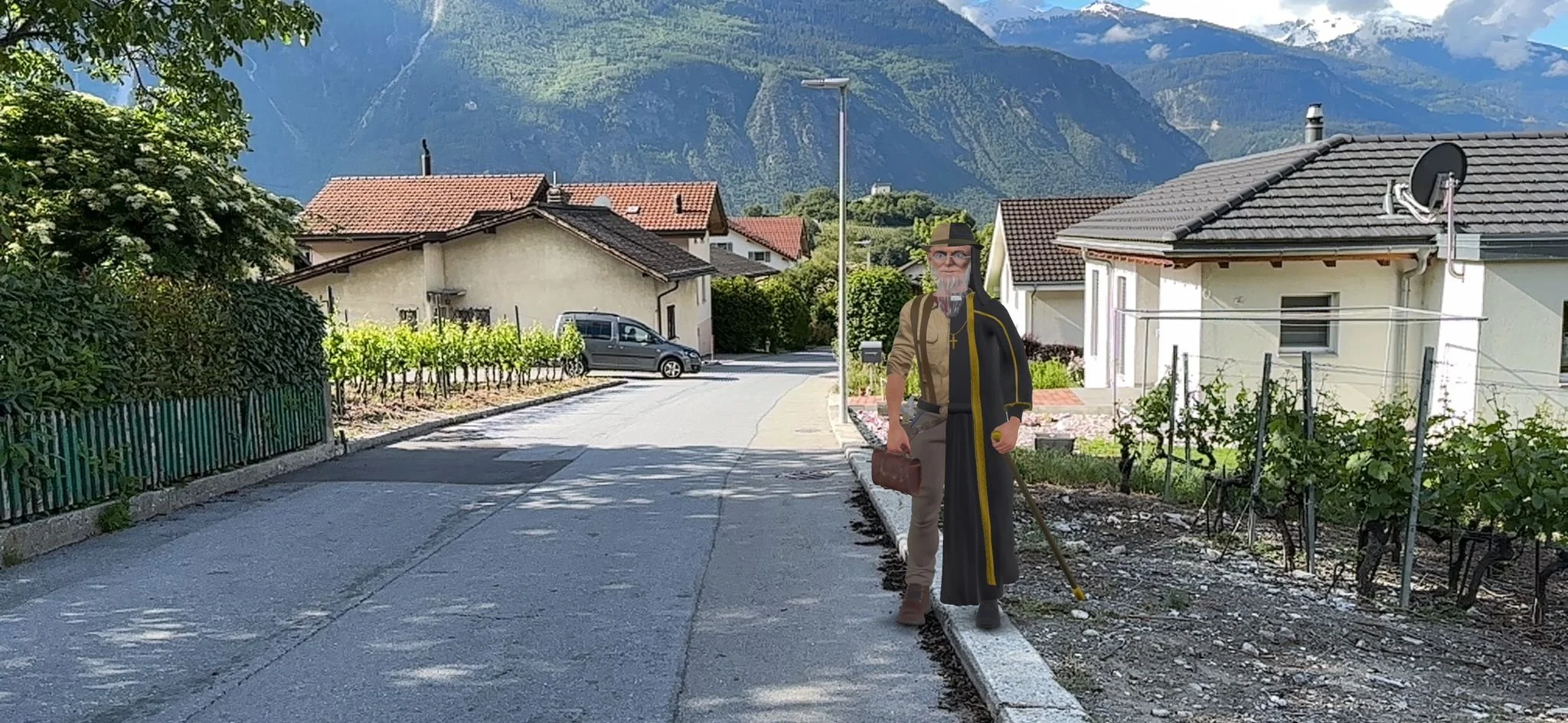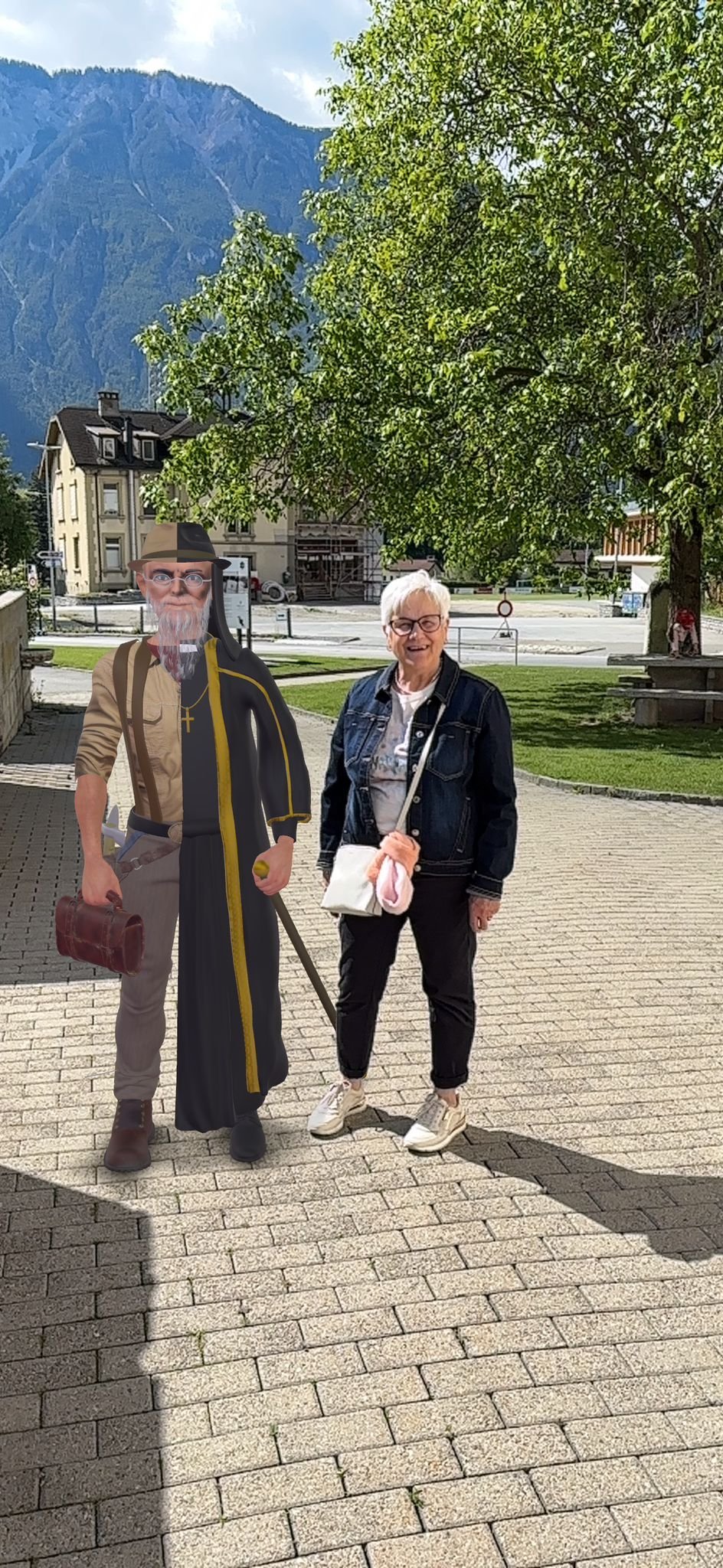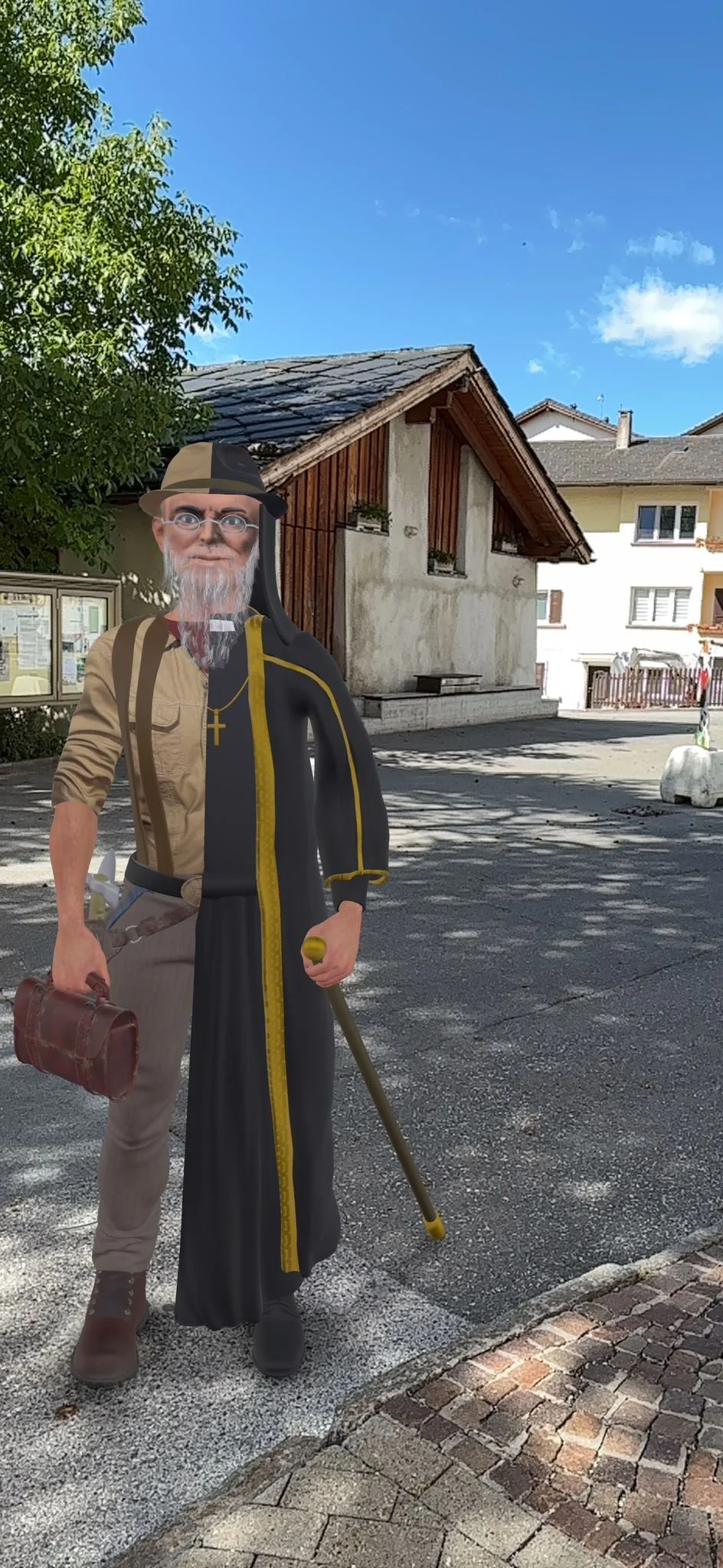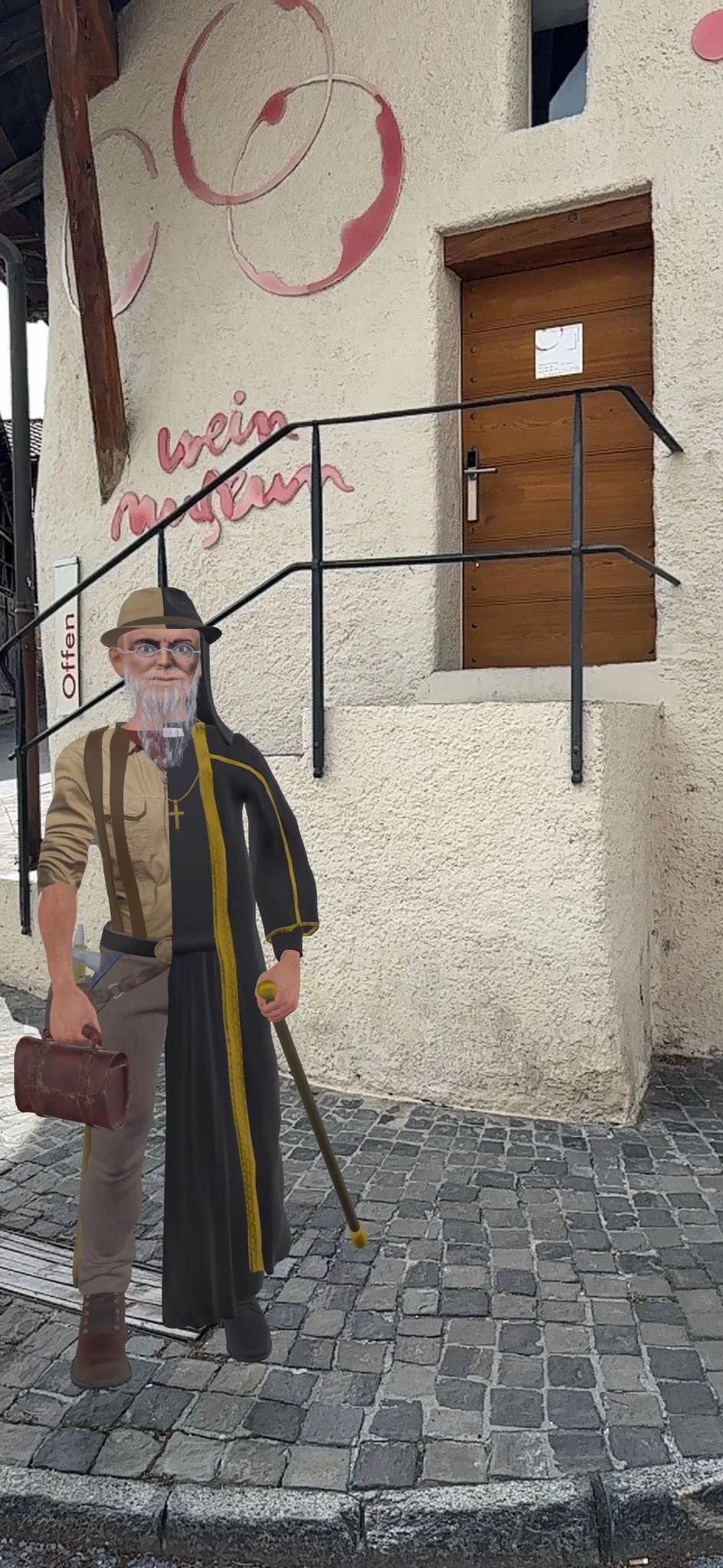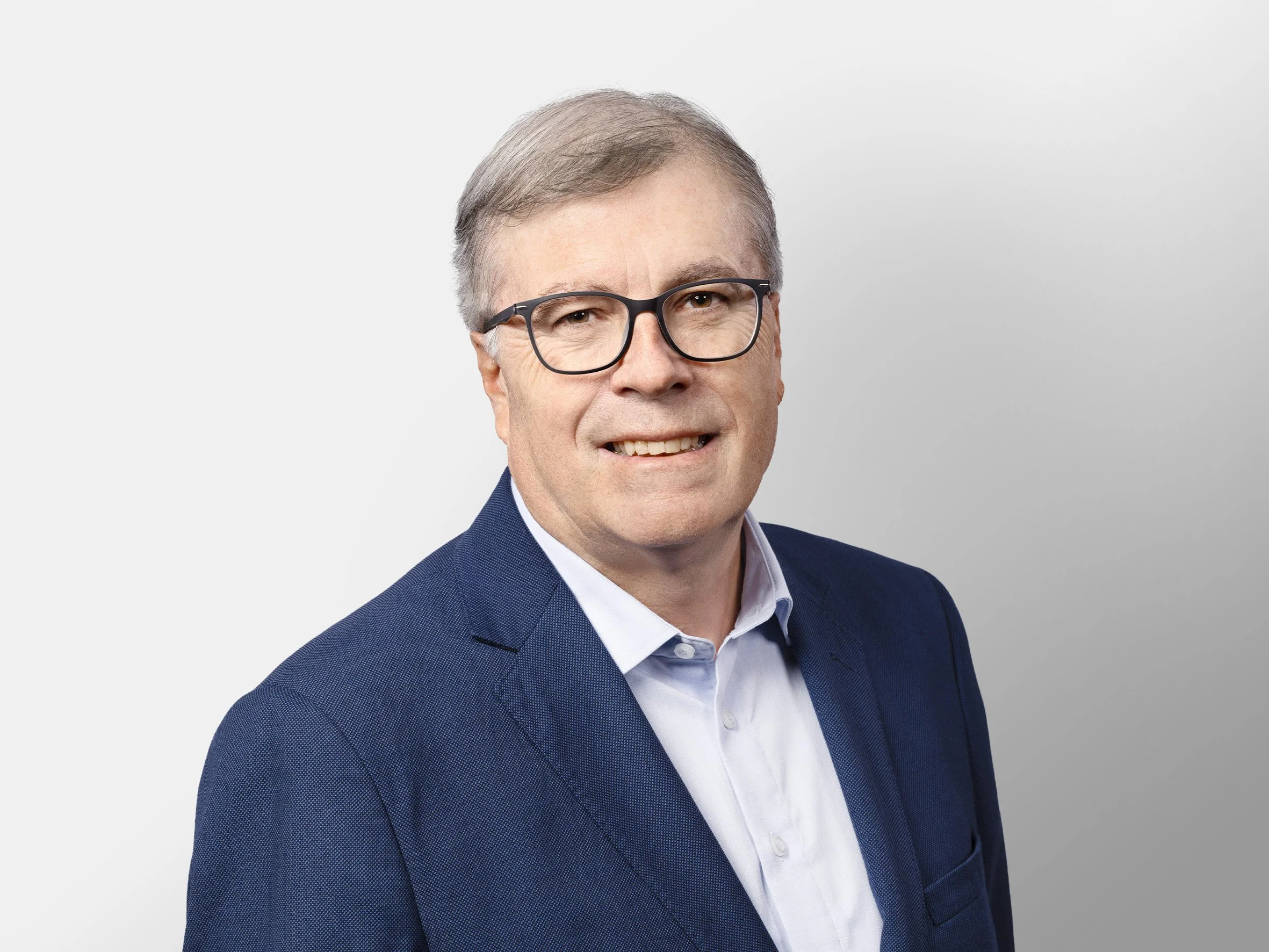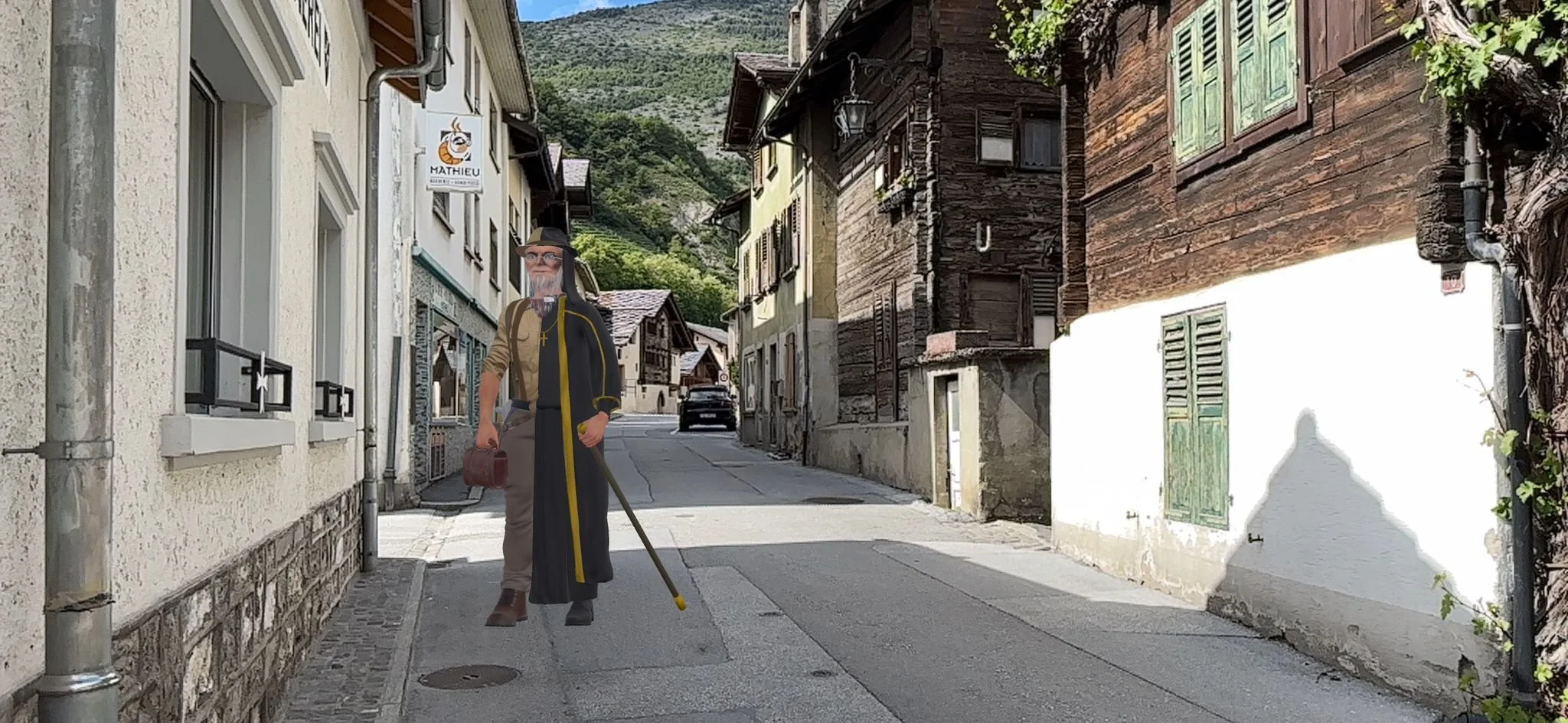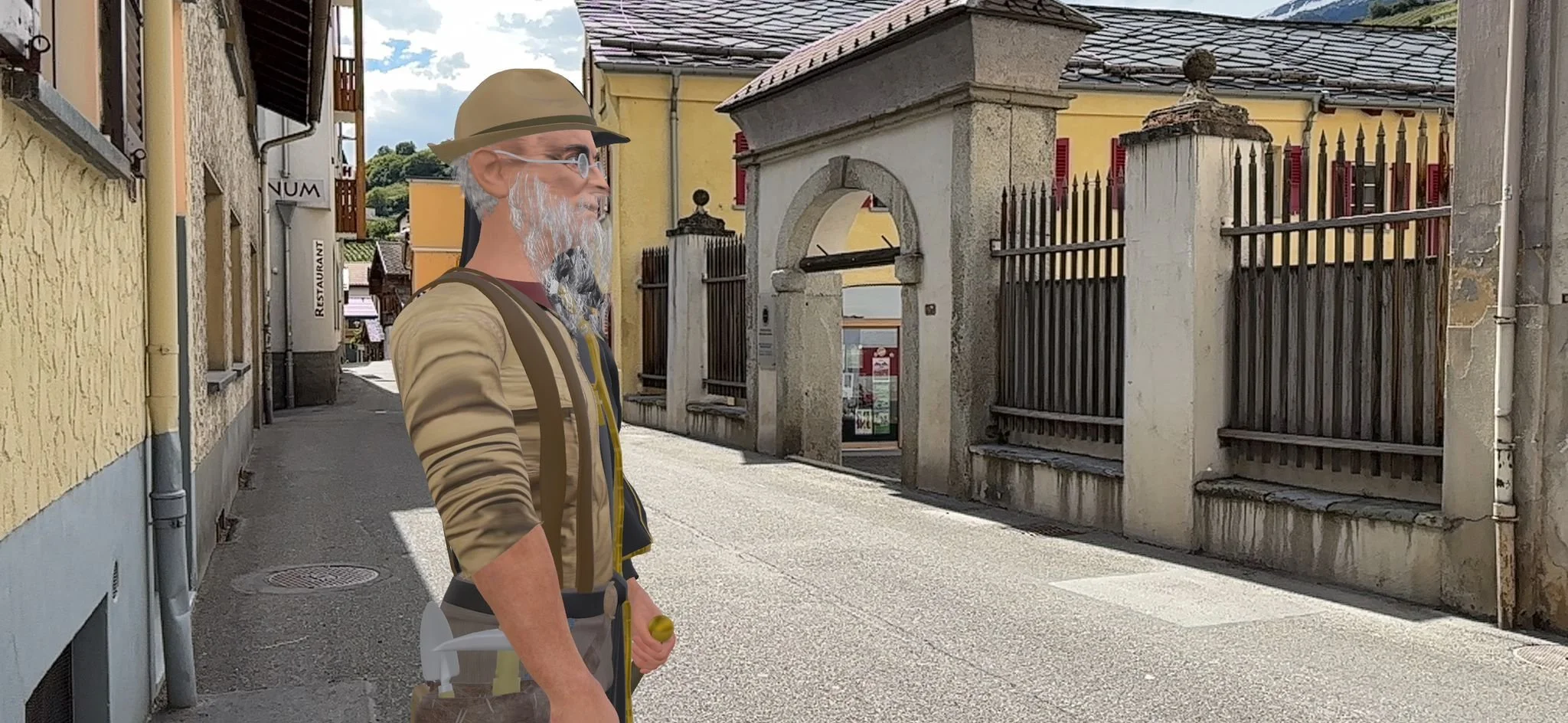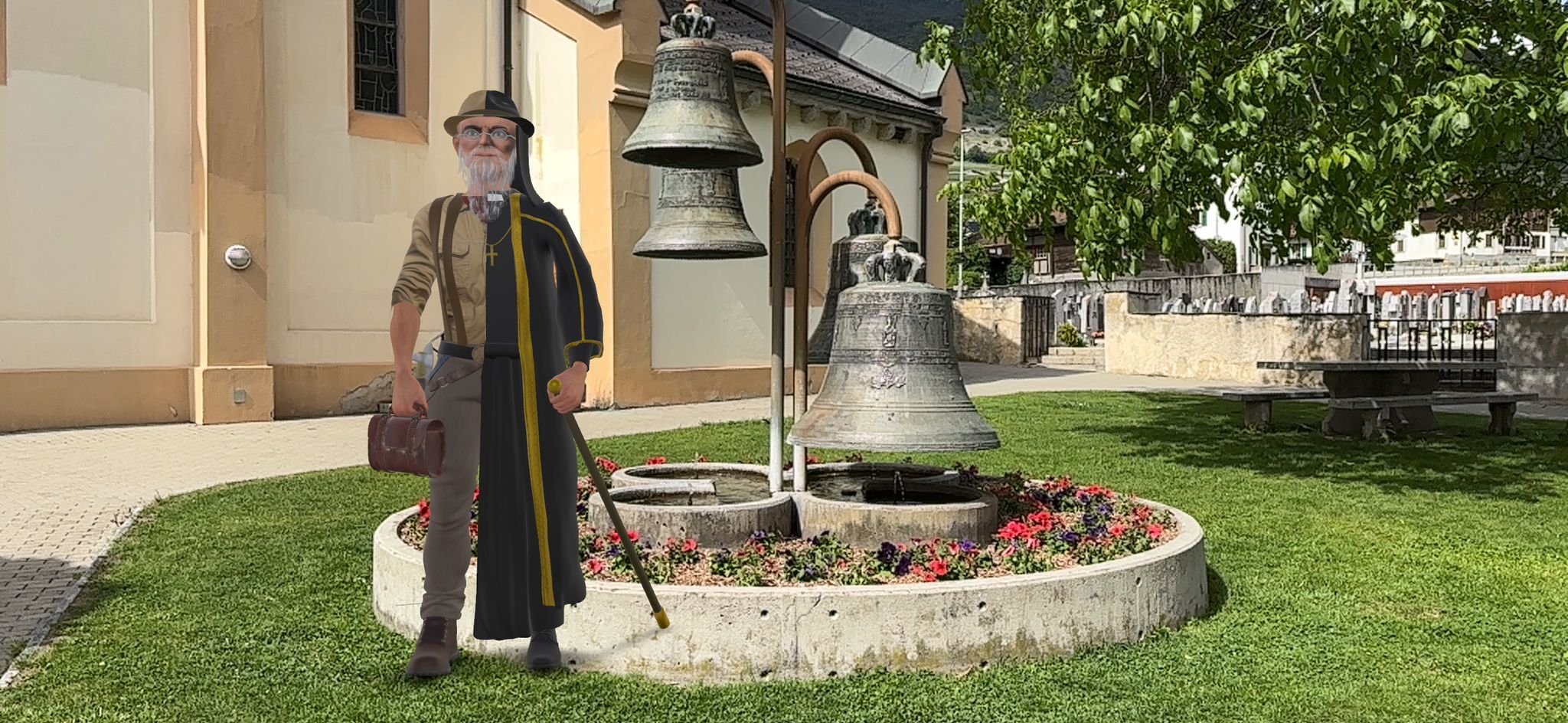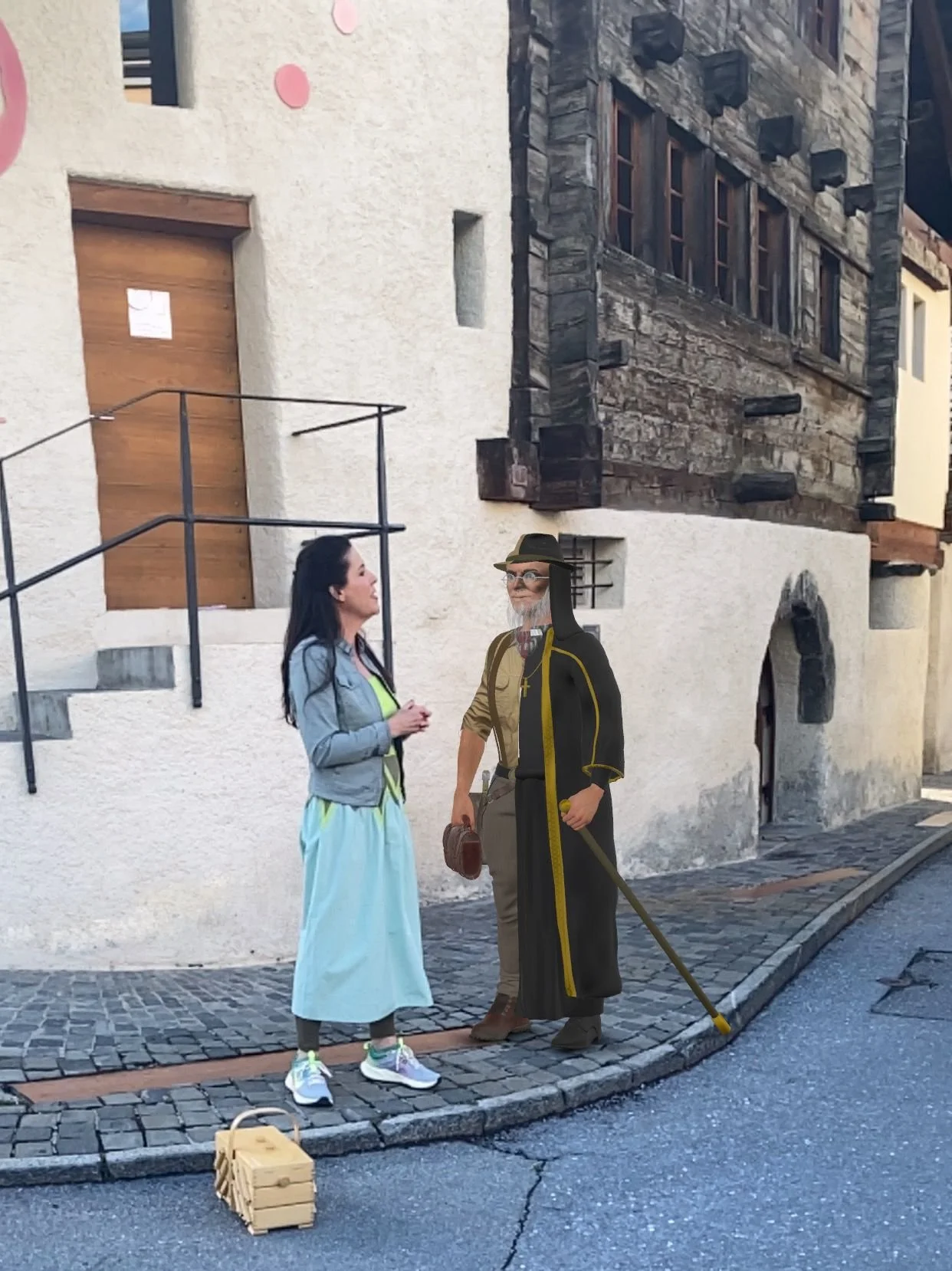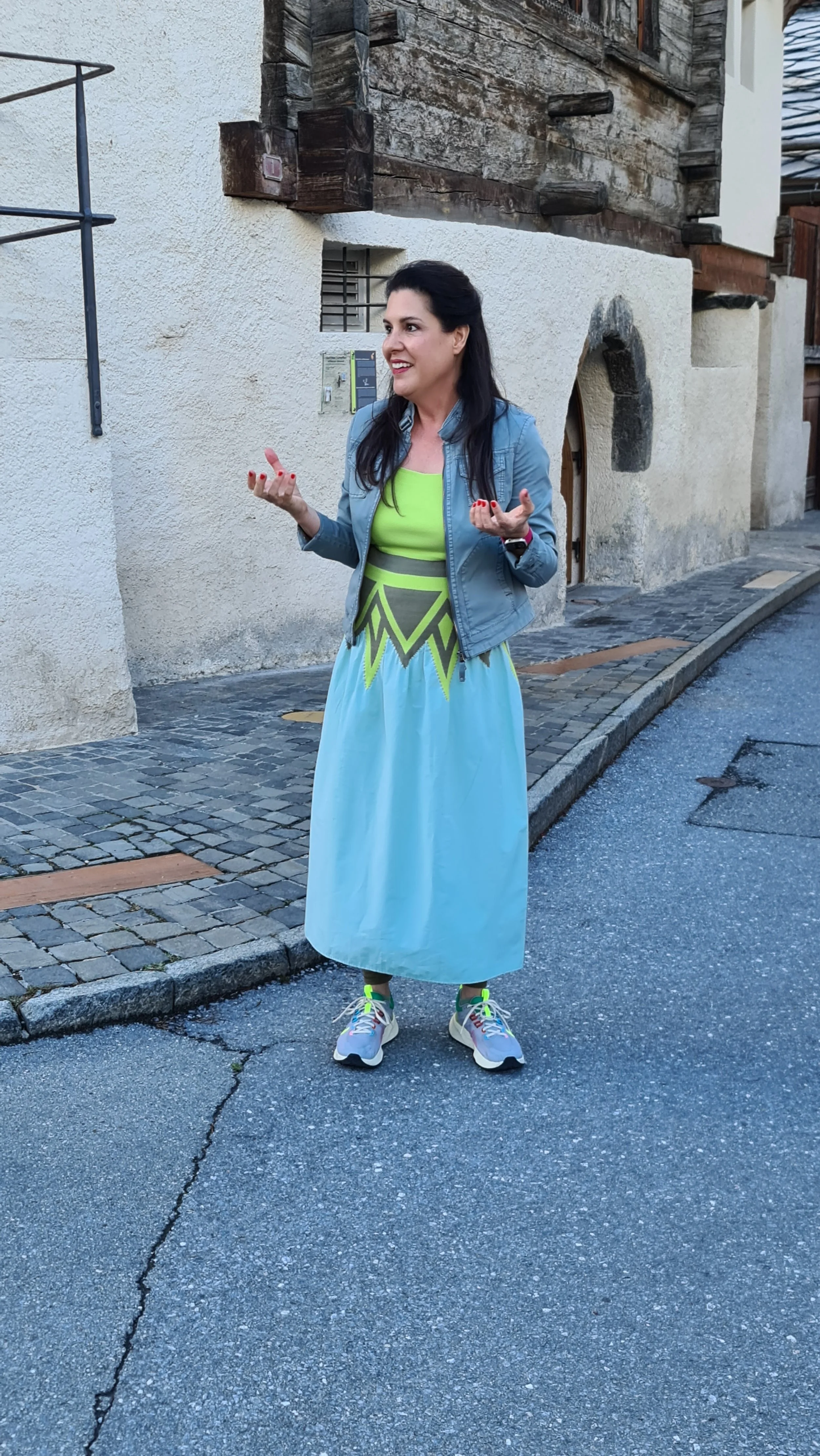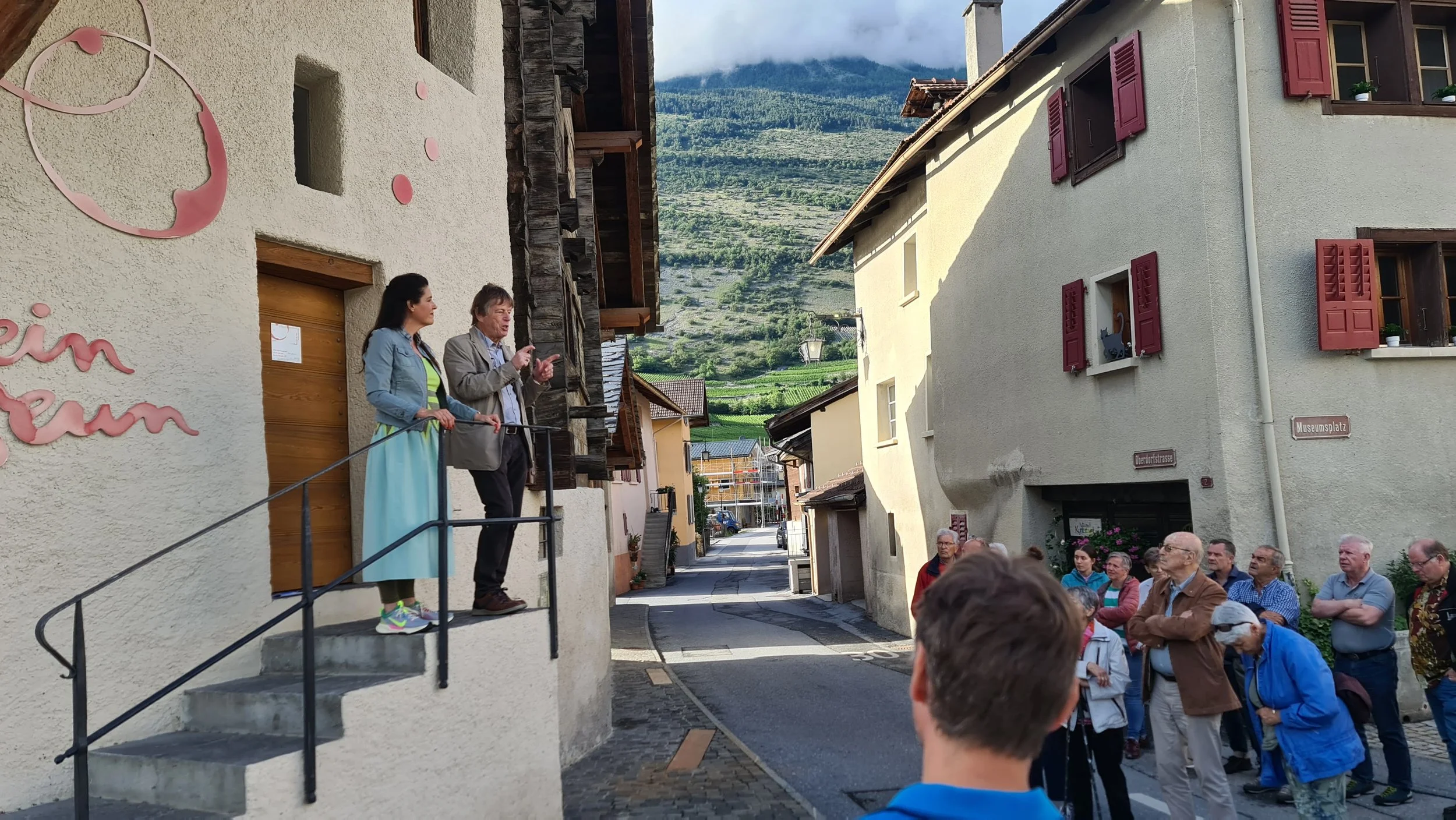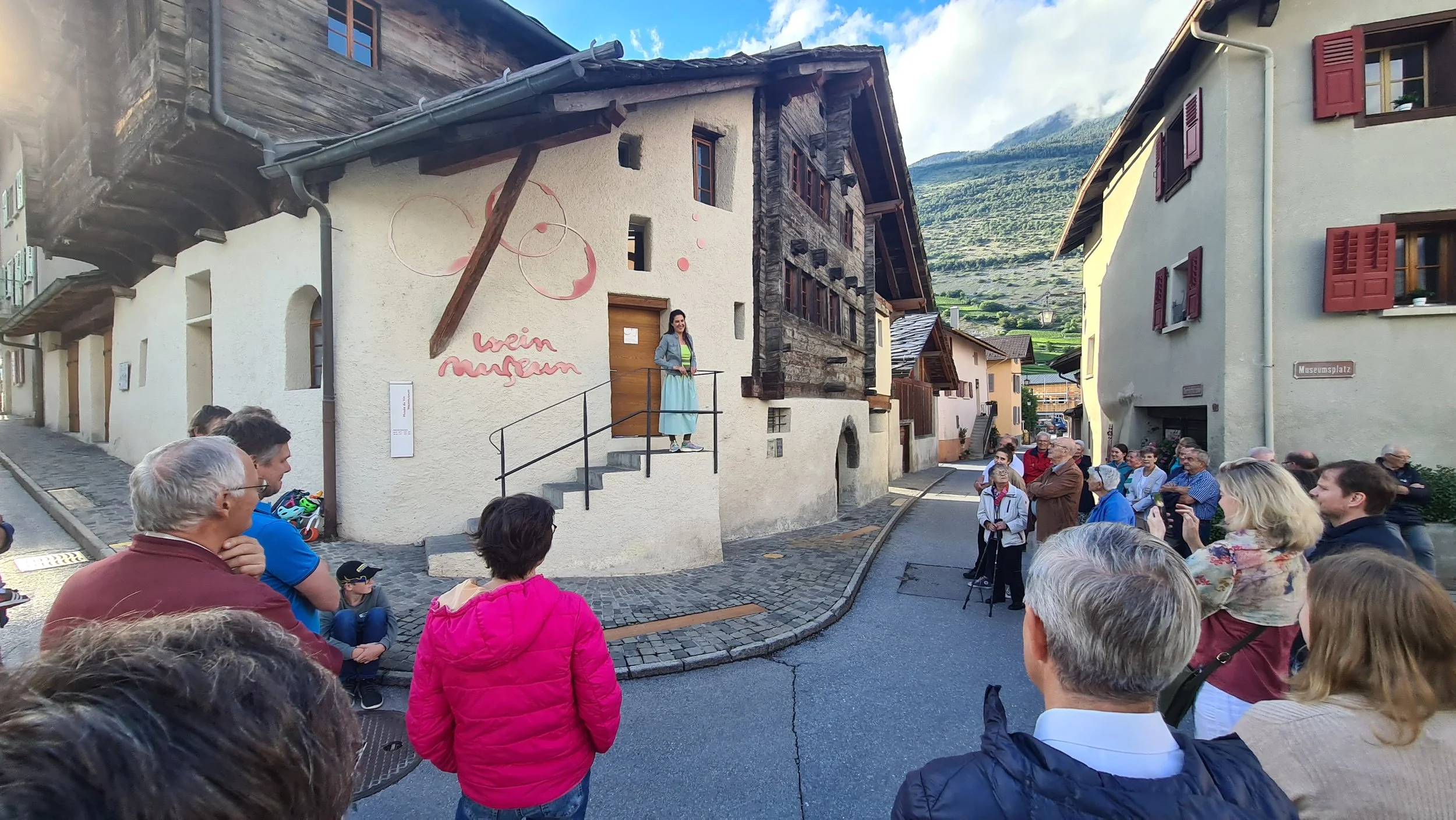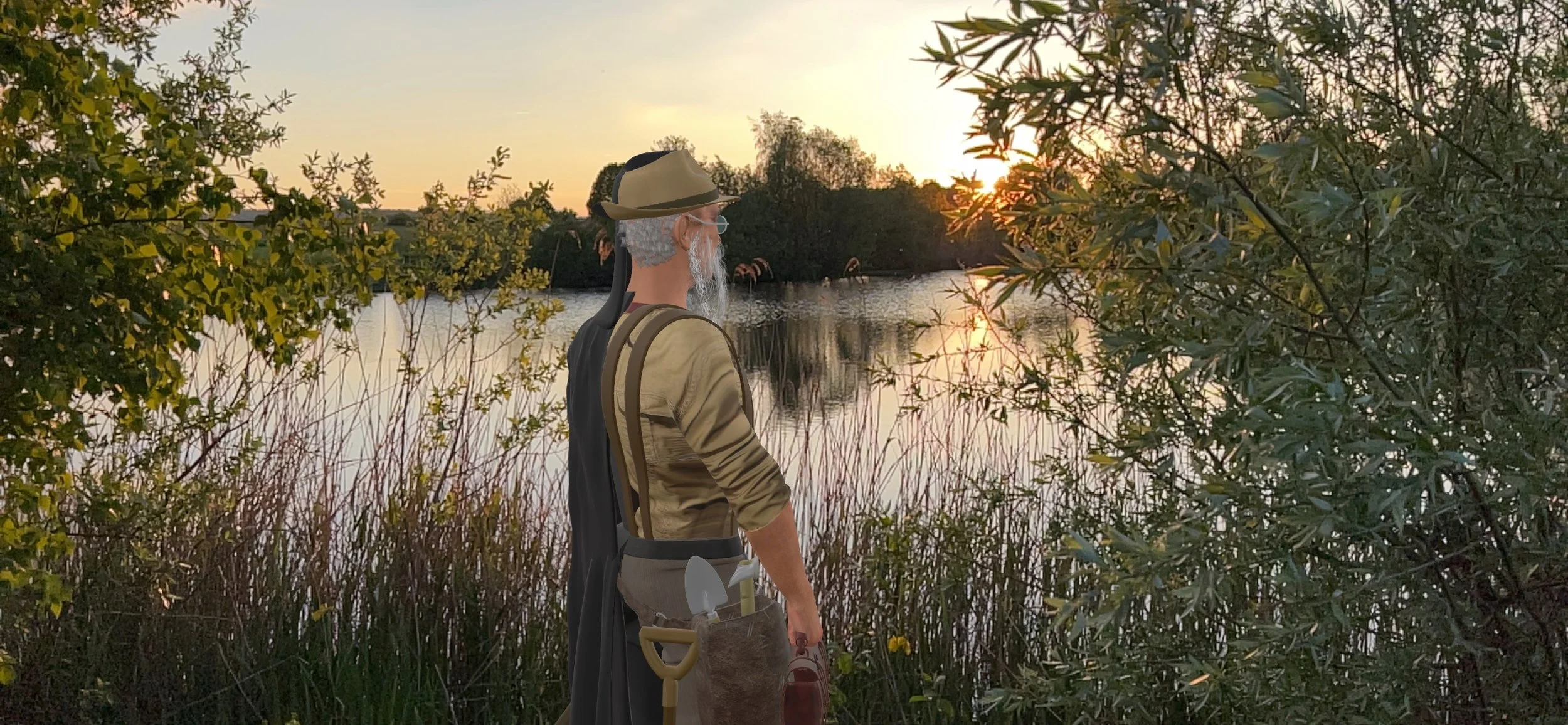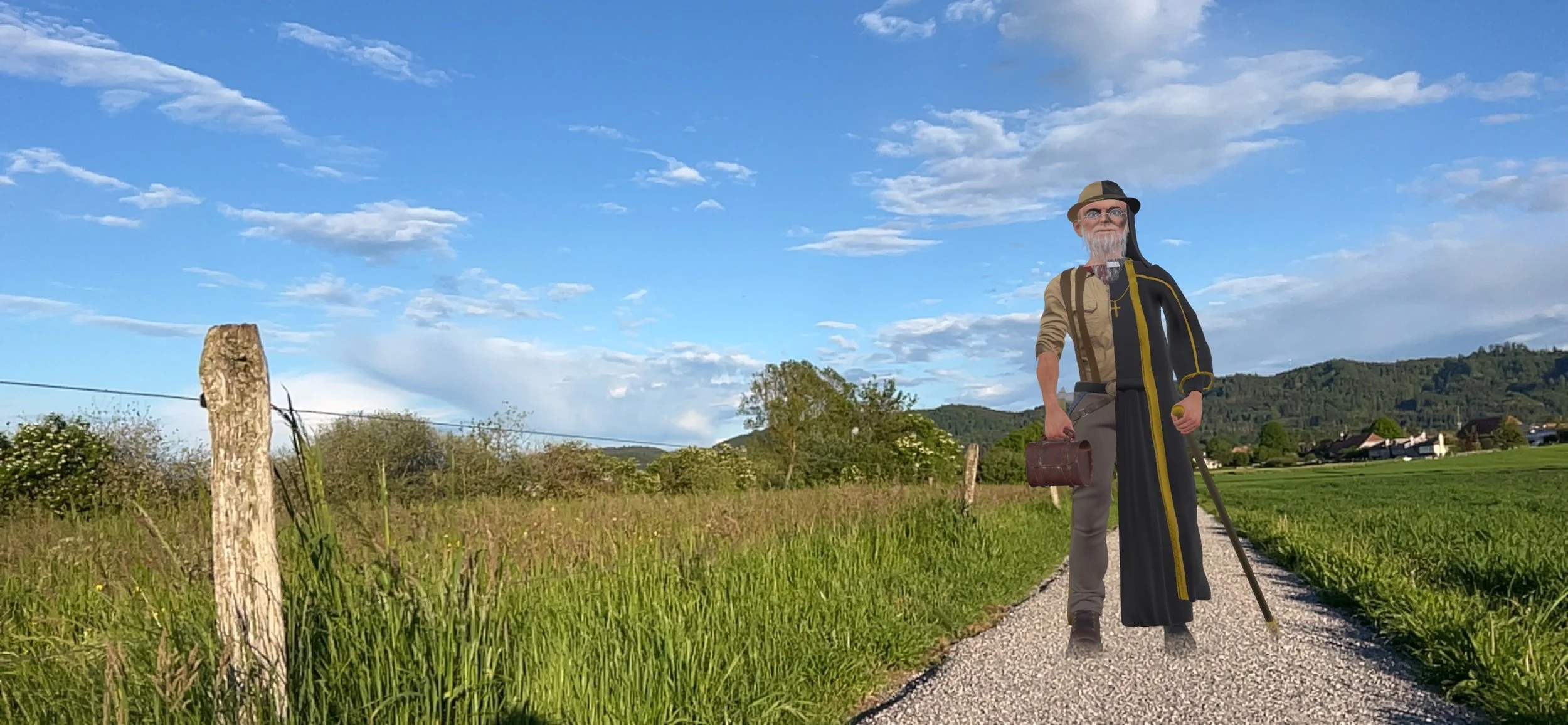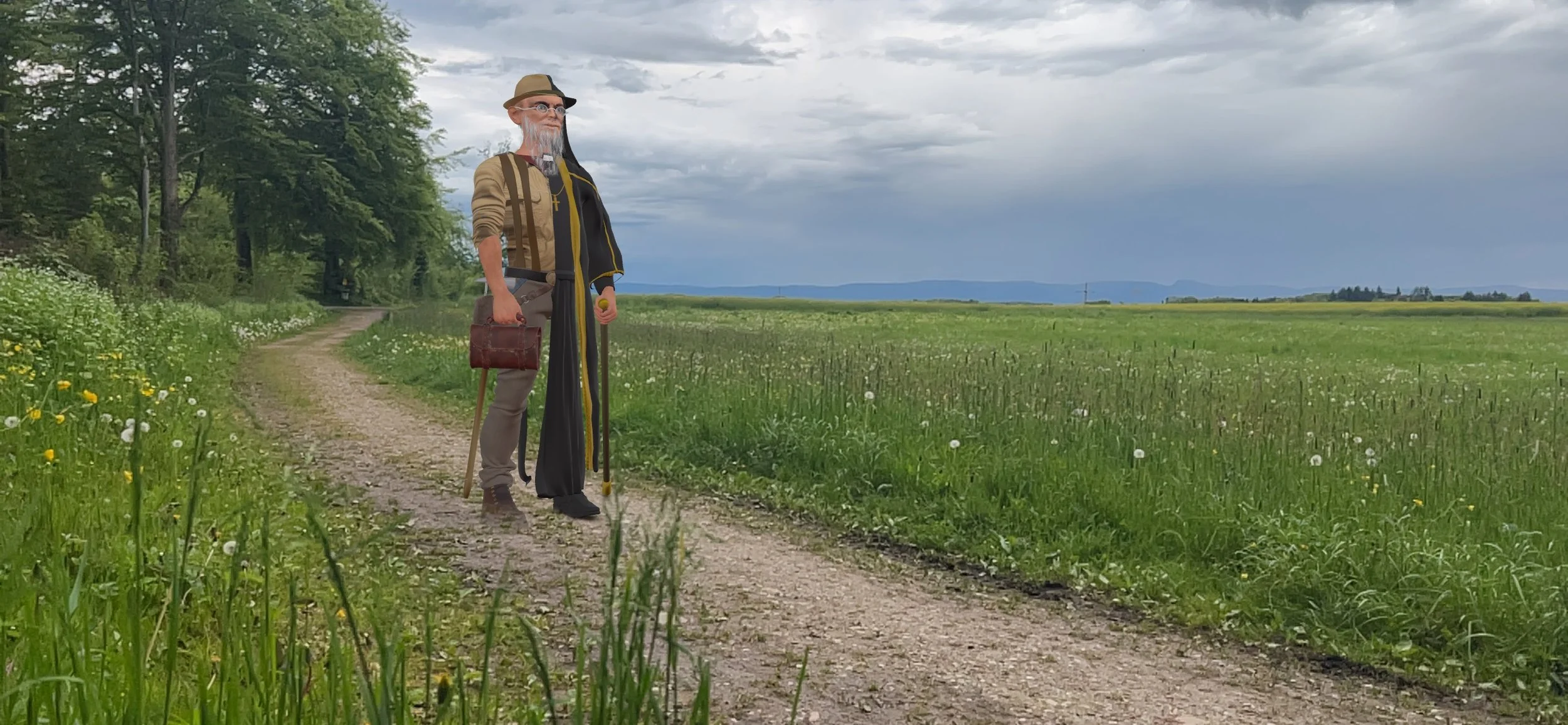
Gottfried Zumoffen Monument
First AR Monument in Europe
Salgesch, Valais: Thank you for this great photo Artinom Vallat (at)virussinside UnsplashGottfried Zumoffen SJ (Societas Jesu)
Gottfried Zumoffen was a Jesuit priest and an archaeologist from Salgesch, Valais in Switzerland. Johann Joseph Gottfried Caesar Zumoffen was born 2 October 1845 in Salgesch and died 1 September 1928 in Beirut. He spoke at least 5 languages and was also a writer, a teacher and a scientist. He has an inspiring biography.
We have decided to bring him to life in augmented reality.
This way you can learn about his curiosity and his drive and get inspired. You can view the monument with your smartphone. We have integreated his photo as a monument in augmented reality, which you can call up with the QR code.
Scan the QR Code with your Smartphone to view the 3D Monument in AR
OR CLICK ON THE LINK BELLOW TO VIEW GOTTFRIED
We protect your data: This is a non-commercial art project, devoid of any data collection. We do not collect any data from you. NoAI: This model may not be used in datasets for, in development, or as inputs to generative AI programs.
Click on the [AR] Button in the bottom right corner and move your smartphone - Enjoy!
Take a photo with Gottfried.
Seline Mounir-Schnyder with Gottfried by the church in Salgesch Credit: Chantal Mounir-Glenz, her daughter
“Salgesch has always been fertile ground for pioneers. This has often been reflected in the creation of the best wines. In this tradition of pioneers, we can now look back on the first AR Monument to be created in Europe. Congratulations to Sarah Montani and the Foundation ‚Johanniterbund Salgesch‘. Innovation paired with faith in the future will continue to inspire this pioneering spirit in Salgesch. Gottfried Zumoffen would be proud.”
Jean-Michel Cina
Citizen of Salgesch, Citizen of Salgesch
Credit: Chantal Mounir-Glenz
Gottfried Zumoffen, a Salgesch native born in 1845, embodied the spirit of lifelong discovery. His forward-thinking and innovative mindset left a lasting impact on our community. Today, the Johanniterbund of Salgesch honors this unique man with an innovative AR Monument, celebrating his legacy in a modern and engaging way. This monument not only pays tribute to Zumoffen's contributions but also brings his inspiring spirit to today's generation, ensuring his memory and values continue to inspire.
Damian Constantin
Citizen of Salgesch, CEO Valais Promotion, Vorstand Switzerland Tourism
22nd June 2024 Salquenen Wine Museum Valais
INAUGURATION OF THE MONUMENT
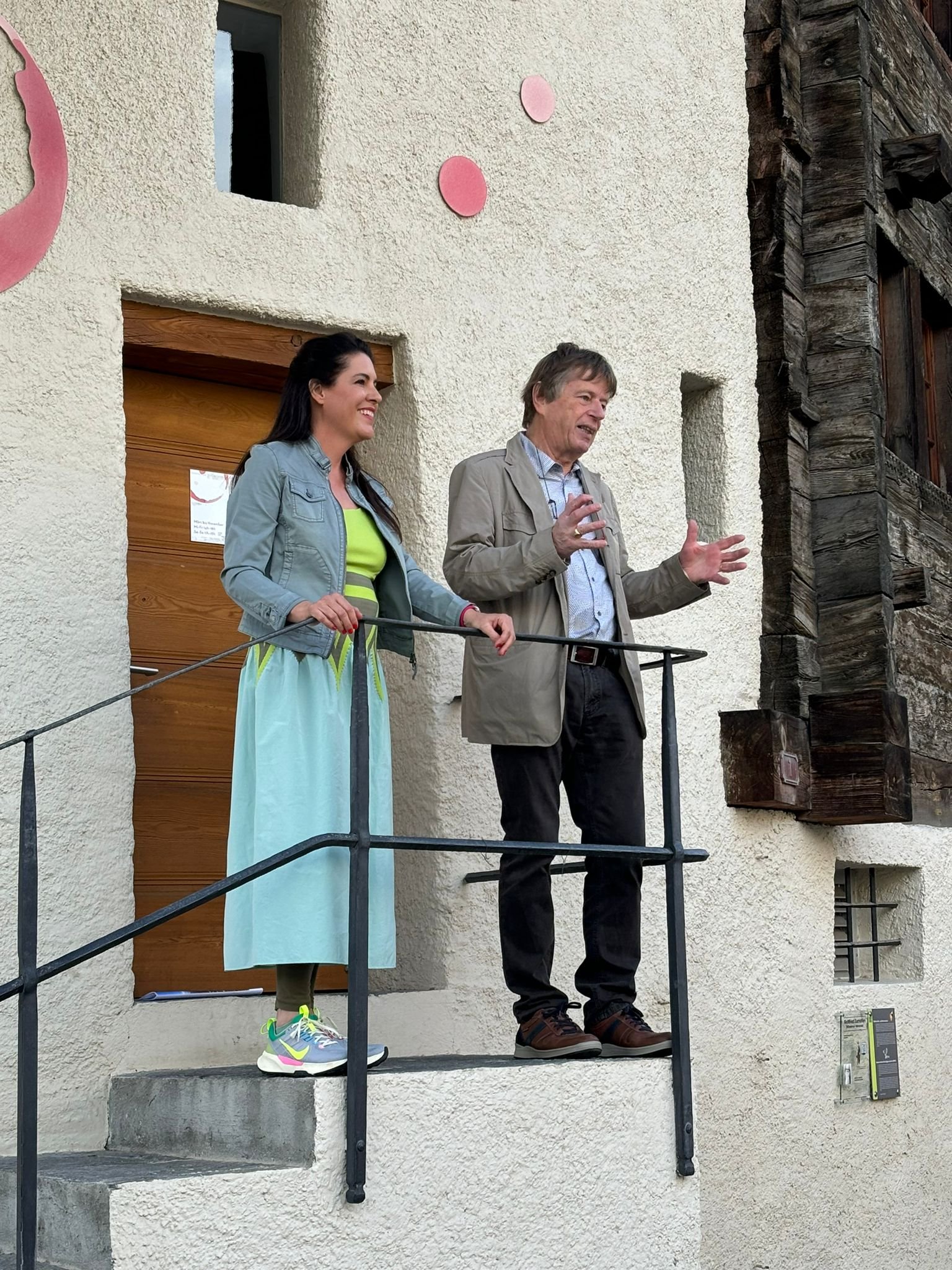
Credit: Sarah Montani and Manfred Mathier from Johanniterbund Salgesch, 22nd June 2024
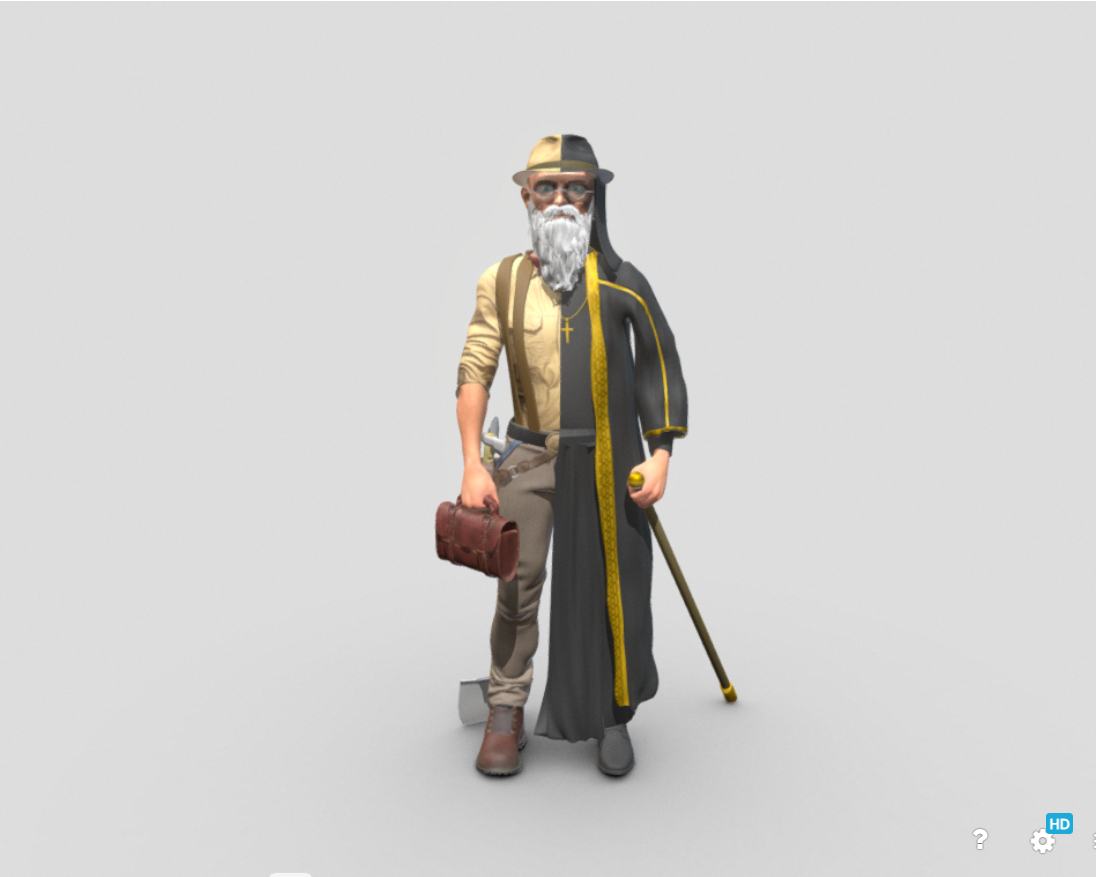
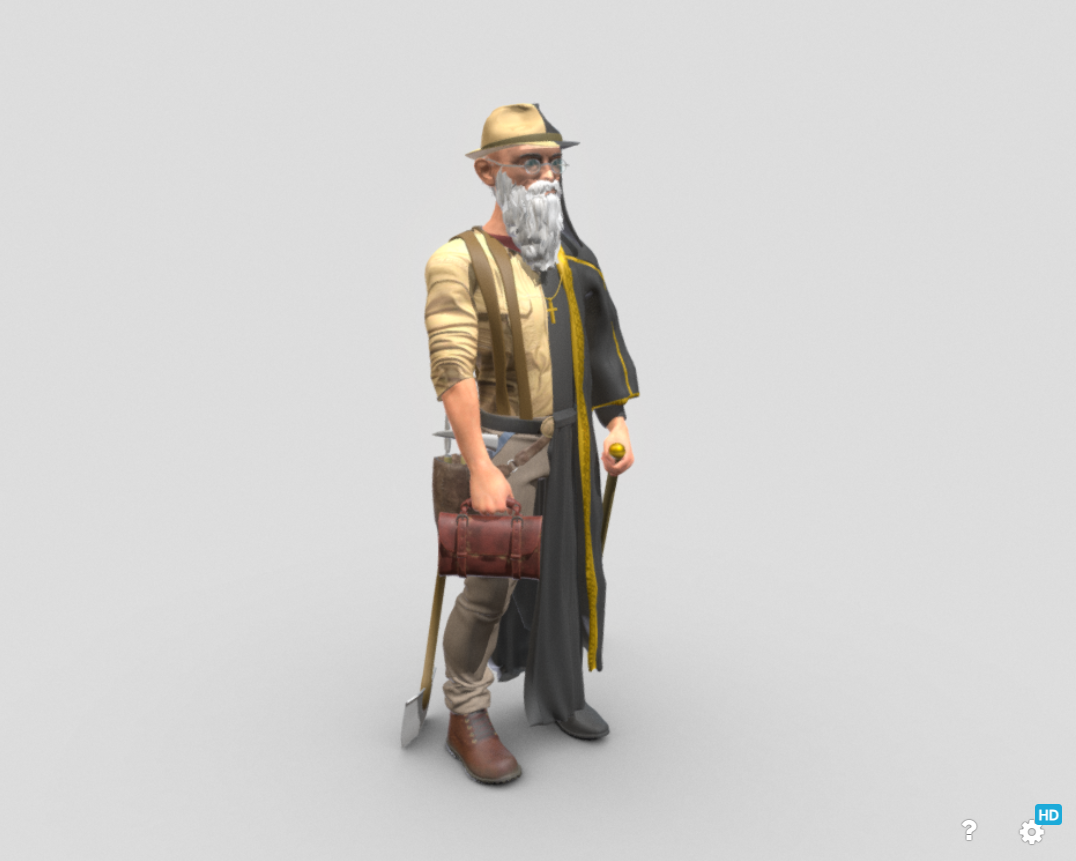
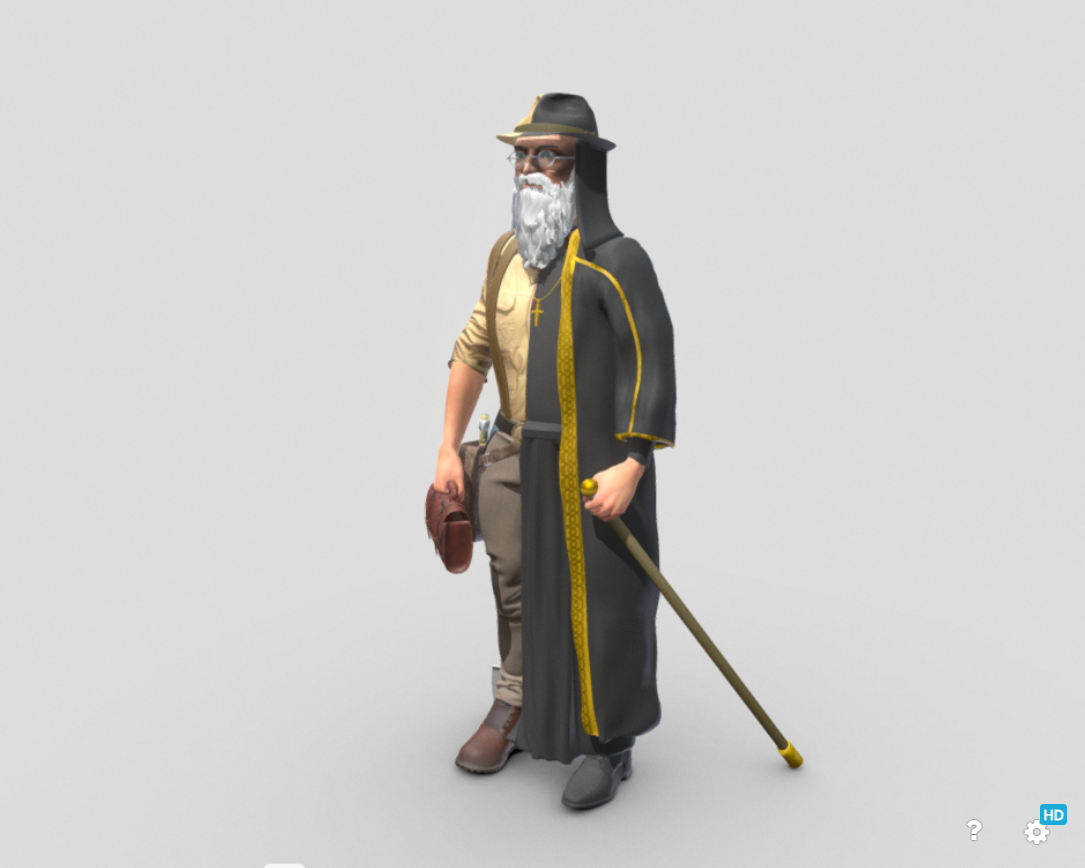
Meet Gottfried Zumoffen live
THE FIRST AR MONUMENT IN EUROPE
From Salgesch to Beirut: the life and legacy of Gottfried Zumoffen
Gottfried Zumoffen, born in Salgesch as the son of Joseph Zumofen, an authorized signatory, and Anna Maria, née Cina, had a remarkable educational and professional career. It is not known why his birth name Zumofen was given a second "f". The fact is that he himself signed his writings Zumoffen.
His education began with elementary school in Salgesch and studies at the teacher training college in Sion. Financial reasons forced him to abandon his subsequent studies at the college in Brig.
A journey through cultures and sciences
In 1871, Gottfried joined the Jesuit order in France and continued his academic education. He attended a grammar school again and studied philosophy. His path then led him to North Wales, where he studied theology and was ordained a priest. He then worked as a priest in southern England and later took on the role of prefect of a Jesuit college in France, where he also worked as a librarian and French teacher.
Paths of discovery: the life of Gottfried Zumoffen, discoverer of history and science
His journey continued to the Ottoman Empire. He learned Turkish and Arabic and took up a post as prefect and lecturer in physics, chemistry and natural history at the University of Beirut. With the outbreak of the First World War, all Jesuits had to leave Lebanon. Gottfried moved on to Cairo and taught chemistry and physics. He eventually returned to Switzerland and worked at the University of Bern.
Crossing borders: Gottfried Zumoffen and the beginnings of Lebanese archaeology
In addition to his teaching activities, Gottfried was a passionate researcher. He wrote books and contributed significantly to the discovery and exploration of archaeological sites in Lebanon. He is considered the founder of Stone Age research in the region and created the first geological map of Lebanon. An important archaeological site was named "Abri Zumoffen" in his honor.
The crowning achievement of his scientific geological, archaeological and paleontological life's work was the publication in Paris in 1926 of a monograph on the geology of Lebanon, on which Father Zumofen had mapped around two dozen archaeological sites.
What was happening in Valais at the time of Gottfried?
In 1884, the first hydroelectric power station was opened in Chippis, the federal constitution was created, the Simplon road and tunnel were built, and he also experienced a pandemic, the Spanish flu. Salgesch did not have electricity until 1924, and at that time there were hardly any cars. The first car in Salgesch was owned by Oswald Mathier. Gottfried Zumoffen traveled a long way: to get to Beirut or Cairo, he first had to travel from Salgesch to Geneva, then to Marseille, probably by horse-drawn carriage and then onwards by sail or steamboat. The journeys probably took several weeks to months. The first railroad station in Salgesch was not opened until 1874, the first Brig - Sion railroad line in 1860. He may also have been able to use the train.
What would Gottfried have said about his monument?
We can't ask him, but the AI gave us the following answer for Gottfried:
"Goodness gracious! If I had known that, I would have made my excavations a lot easier. Instead of digging in the dust for days on end, I would have just put on these AR glasses and voilà - the ancient world in 3D! But you know, my friend, you lose the charm of the craft. A real archaeologist needs dirt under his fingernails and the smell of old books in his nose. But I have to admit, this technique has its charm. And it would have made so much of my work easier if I could have used it."
Clothe recyling
In the Valais at the time of Gottfried, poor people had a hard everyday life characterized by agricultural work, livestock farming and a certain degree of self-sufficiency. At this time, Valais, like many rural regions in Europe, was affected by poverty and difficult living conditions. Many families lived from subsistence farming, growing their own food and keeping animals such as goats, sheep and cows for milk, meat and wool. Clothing was often made from wool from their own sheep. Women spun the wool into yarn and wove fabrics from which they sewed clothes.
Clothing was worn for as long as possible, often patched and mended. Old clothes were recycled and reworked into new garments. The artist furnished Gottfried with recycled clothes. She recalled a story from her grandfather, who told her that when he had outgrown his trousers, a new pair was sewn for him from a scratchy, yellowed curtain. As Gottfried also came from a very modest background and had to abandon his studies for financial reasons, she portrayed him as self-sufficient.
(Source: Wikipedia, Karl Zimmermann: Gottfried Zumoffen (1845-1928) and his archaeological research in Lebanon, in: Blätter aus der Walliser Geschichte, 1988, pp. 273-285)


